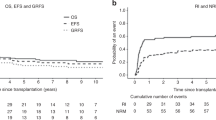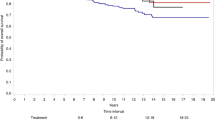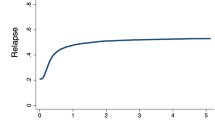Abstract
In 1991 we reported the results from a prospective randomised phase 3 trial comparing 7 days continuous infusion of cytosine arabinoside (ara-C) combined with either daunorubicin (DNR) or aclarubicin (ACR) as direct i.v. injection for 3 days as induction chemotherapy (CT) for patients with de novo acute myeloid leukemia (AML) followed by early intensive consolidation CT with two alternating cycles of high-dose ara-C and two cycles of amsacrine plus etoposide, and finally 3 days of daunomycin plus 7 days of ara-C as administered for induction of remission. A total of 174 patients with de novo AML in the age group 17–65 years were included. The patients have now been followed till death or for at least 7 years, and an evaluation of the long-term survival and the risk of developing secondary neoplasms has been made. The overall survival rate 5-years after diagnosis was 23%, and after 10 years 19%. No difference was found between the two treatment regimens in overall survival or disease-free survival (DFS). For the subgroup of 99 patients who achieved complete remission after one or two induction courses, 5- and 10-year survival rates were 35% and 31% respectively, with the highest survival rates in the age group 17–39 years (57% at 5 years) as compared with 27% in patients aged 40–60 years (P = 0.007). Seven secondary neoplasms were diagnosed simultaneously with or after the diagnosis of AML indicating a standardized incidence ratio (SIR) of 3.41, (95% CI: 1.60–7.26). In three cases the secondary neoplasms were diagnosed simultaneously with the AML diagnosis and were for that reason completely unrelated to the chemotherapy administered for AML, as the psammomatous meningeoma diagnosed after only 8 months. The remaining three neoplasms which developed subsequently did not significantly exceed the expected number, with a SIR = 1.46 (0.47–4.57). Thus, no increased risk of solid tumors causally related to the intensive chemotherapy for de novo AML was observed. However, a generally increased risk of solid tumors in patients diagnosed simultaneously with the AML diagnosis seems likely. Over 20% of the patients were alive and in complete remission 5 years after the AML diagnosis, and they have a high probability of surviving the next 5-year period.
This is a preview of subscription content, access via your institution
Access options
Subscribe to this journal
Receive 12 print issues and online access
$259.00 per year
only $21.58 per issue
Buy this article
- Purchase on Springer Link
- Instant access to full article PDF
Prices may be subject to local taxes which are calculated during checkout
Similar content being viewed by others
Author information
Authors and Affiliations
Consortia
Rights and permissions
About this article
Cite this article
de Nully Brown, P., Hoffmann, T., Hansen, O. et al. Long-term survival and development of secondary malignancies in patients with acute myeloid leukemia treated with aclarubicin or daunorubicin plus cytosine arabinoside followed by intensive consolidation chemotherapy in a Danish national phase III trial. Leukemia 11, 37–41 (1997). https://doi.org/10.1038/sj.leu.2400514
Received:
Accepted:
Issue Date:
DOI: https://doi.org/10.1038/sj.leu.2400514



